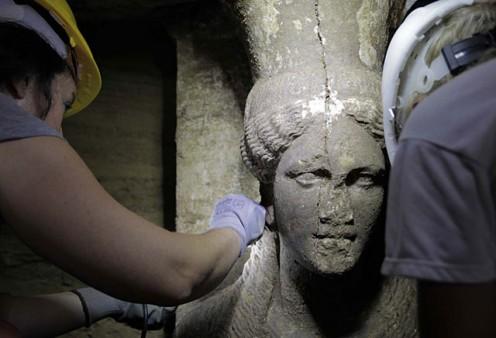Source - http://www.archaiologia.gr/en/blog/2014/09/08/amphipolis-two-caryatids-of-exceptional-artistry-found/

Amphipolis: The western caryatid
Two caryatids of exceptional artistry carved in Thasian marble were revealed on Saturday afternoon (September 6), during the ongoing excavations at the Casta hill burial monument in ancient Amphipolis (Greece). The high artistic value of these sculptures further supports the suggestion that the Amphipolis tomb belonged to a person high up in the Macedonian hierarchy.
Though the importance of the monument is beyond doubt, one cannot jump into conclusions regarding the findings, archaeologists of the Culture Ministry stress, as months of work in libraries etc. will be needed in order to answer the big questions raised by the impressive excavation results.

Amphipolis: The western caryatid’s face is almost intact.
According to the newest announcement of the Culture Ministry, the western caryatid’s face is almost intact while the eastern caryatid’s face is missing.

Amphipolis: The eastern caryatid’s face is missing
Both sculptures have rich curls that cover their shoulders, wear earrings and a sleeved chiton. The western caryatid’s right arm and the eastern caryatid’s left arm –both inlaid– are outstretched, a gesture which seems to symbolically block the entrance to those attempting to enter the tomb.
The caryatids show a technique similar to that used at the two sphinxes found at the first diaphragmatic wall. Traces of red and blue color were found on the sculptures – a feature referring to the Kore female statues.
Under the sandy soil fragments of the statues were located, e.g. part of a palm and smaller fragments of their fingers and their faces.
Only the upper part of the caryatids has been revealed so far. The rest remains buried in the ground.

Amphipolis: The 4.5 meters wide sealing stone wall in front of the caryatids.
Another important find is the 4.5 meters wide sealing stone wall in front of the caryatids. This second sealing wall follows the same technique as the tomb’s entrance wall. According to experts, this wall was also meant to stop anyone attempting to enter.
It should be noticed that this is the first time that caryatids, a statue type characteristic of ancient Athens, were found at a Macedonian tomb.
On Friday, September 6, two meters from the tholos and 4.5m from the floor a marble rectangular slab was found (4.2x1x0.21m). It is excellently preserved.

Amphipolis: The excellently preserved marble rectangular slab
The slab rests on the tuff stone of the third diaphragmatic wall and the upper part of the marble revetment which is decorated with a moulding.

Amphipolis: The slab rests on tuff stone of the third diaphragmatic wall.
At the lower part of the slab painted decoration in blue, red and yellow colour was found, picturing coffers with rosettes in the center. This is part of the ceiling of the room examined.

Amphipolis: At the lower part of the slab painted decoration in blue, red and yellow colour was found, picturing coffers with rosettes in the center.